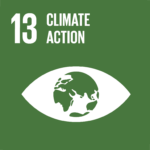Along Indonesia’s coastline lies more than 3.3 million ha of mangrove forests. This accounts for about 23 per cent of all mangrove ecosystems in the world; storing over 3 billion tonnes of carbon.
Indonesia, home to some of the world’s most critical mangrove ecosystems, has announced an ambitious plan to rehabilitate 600,000 hectares of mangroves by 2024. However, as the deadline approaches, progress remains far behind target. With only 150,000 hectares restored—just 25% of the goal—experts are questioning whether the initiative can overcome its significant financial, logistical, and social challenges.
RELEVANT SUSTAINABLE GOALS




Mangroves: A Key to Climate and Coastal Resilience
Mangroves, which provide essential protection against coastal erosion, carbon sequestration, and support for biodiversity, are a cornerstone of Indonesia’s environmental strategy. As the largest archipelagic nation, Indonesia possesses the most extensive mangrove forests in the world. Yet, these ecosystems are under siege from deforestation, aquaculture expansion, and climate change, necessitating urgent rehabilitation efforts.
The government’s commitment to restoring mangroves is part of its larger climate agenda. President Joko Widodo’s ambitious target of rehabilitating 600,000 hectares by 2024 is seen as critical to reducing emissions and protecting coastal communities. However, the gap between ambition and implementation is stark.
Progress Hampered by Budget and Coordination Issues
The Peatland and Mangrove Restoration Agency (BRGM), which oversees the initiative, reported that as of December 2024, only 150,000 hectares had been rehabilitated. Suwignyo Utama, head of the BRGM’s public education team, attributed the slow progress to multiple factors, including budget constraints and the complexity of coordinating restoration efforts.
“Funding has been a significant hurdle in achieving our goals,” Suwignyo explained during a recent briefing in Jakarta. The restoration process is not only resource-intensive but also technically challenging, as mangroves require specific ecological conditions to thrive.
BRGM does not have direct control over land, making coordination with landowners and government agencies essential. For example, when mangroves are slated for restoration on forestry land, BRGM must collaborate with regional forestry offices. Similarly, when the land belongs to local communities, extensive socialization efforts are required.
Resistance from Local Communities Adds Another Layer of Complexity
A surprising challenge has come from local communities, some of whom have resisted using their land for mangrove restoration. “Many landowners do not agree to have their areas designated for restoration, which halts the process entirely,” Suwignyo noted.
Such resistance often stems from a lack of understanding about the long-term benefits of mangroves or concerns about losing access to land for other uses, such as aquaculture or agriculture. BRGM’s public education campaigns have faced difficulties in bridging this gap, further delaying progress.
Despite these hurdles, the stakes for mangrove restoration in Indonesia could not be higher. Mangroves are critical to combating climate change, with their dense root systems storing up to four times more carbon than tropical rainforests. They also act as natural barriers, shielding coastal communities from storm surges and flooding.
Failure to meet the 600,000-hectare target risks not only exacerbating environmental degradation but also undermining Indonesia’s global commitments to climate action.
Looking Forward: What Needs to Change
To accelerate progress, BRGM must address the key challenges undermining the initiative:
- Increased Funding: Securing more robust financial support, either from government budgets or international donors, is essential to scaling up restoration efforts.
- Enhanced Collaboration: Strengthening coordination between BRGM, local governments, and landowners can help streamline the restoration process.
- Community Engagement: Expanding public education campaigns to emphasize the long-term economic and environmental benefits of mangroves could reduce resistance from landowners.
While the challenges are steep, experts believe that Indonesia’s mangrove rehabilitation program is critical to the nation’s ecological and economic future. As Suwignyo aptly stated, “Our efforts are complex, but the outcomes will benefit us all.”
With only a year left to achieve its target, Indonesia’s mangrove restoration plan teeters between ambition and reality. The initiative serves as a microcosm of the broader global struggle to balance environmental sustainability with economic and social constraints.
Indonesia’s success—or failure—will not only shape its coastal landscapes but also serve as a benchmark for global mangrove conservation efforts in the face of a rapidly changing climate.
Lead image courtesy of Andry Denisah / Alamy (Planting mangroves in Kendari bay, Indonesia)
You may also be interested in :
The 30×30 Southeast Asia Ocean Fund: A New Hope For Marine Conservation Announced at COP16



